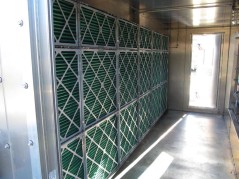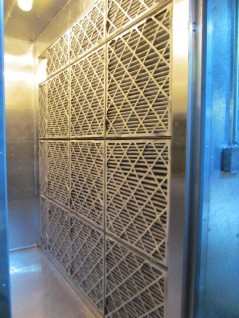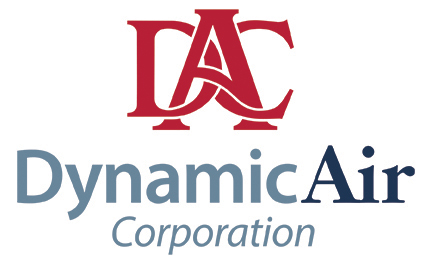Ask Rick: We are working on a lab application and considering not using filters on the exhaust side in front of the energy recovery device. I would like to hear the pro’s and con’s on why not to install filters. This will help us in designing future projects. I would think the efficiency would fall off with a dirty coil pretty quickly. Your thoughts would be appreciated.

Energy Recovery Filter Section
Just skip the pre-filters in front of the exhaust side of the energy recovery device? Is that wise? We know that adding filters impact costs:
- cost to purchase pre-filters
- labor to change
- disposal costs
- increased pressure drop
How do the actual economics shake out, can we both maintain our device and save money?
We went to the source. Here are actual opinions from respected engineers that work in our HVAC community.
“On our heat wheels we feel filters on the discharge are not necessary for lab or office environments. We view it as an initial cost savings and a long term cost savings of energy and maintenance. We are assuming that these indoor environments are relatively clean, and heat wheels are somewhat self-cleaning.
With regard to a run around coil I’d probably not want filters for the cost reasons outlined above. However, if the coils had a close fin spacing similar to a cooling coil, or the environment being conditioned were not clean like an office, I’d probably want the filters.” Design Engineer – University

Exhaust Side Filter Section
“I looked at the filter sections of the units in one of our new buildings. They have not been changed since we moved into the building 3+ years ago, but they do need to be changed out. They have collected enough on the filters to prove that we are better off with them and that we would have had to clean them last year without the filters.
It is a major undertaking when we have to remove the filters, which has to be worked out with our safety department. Even with this said, I feel I would leave in the filters for several reasons.
1) Glycol systems need all the help they can get with heat transfer. Without the filters they would lose efficiency during the years in service until it is cleaned again. 2) Putting on a Tyvek suit, gloves, booties and dust mask to remove the filters and place them into a plastic bag would be easier than the alternative. Hiring a crew to come in with their PPE, spaying down the coils, and cleaning up the fluid is a terrible job. Then we would need to determine how to dispose of it.
I believe keeping a 10 to 12 row coil clean with filters is easier than trying to chemically clean it every 4 of five years.” Facilities System Specialist – Pharmaceutical
My opinion on this is that it depends on what kind of lab is it . . .
If it is a clean lab, prefilters for an exhaust energy recovery coil make no sense.
If it is a lab that has high efficiency filters on the air supply side, it probably makes no sense . . .
But If it is a lab that creates dust or there is a possibility that debris can be drawn thru fume hoods or any other high velocity exhaust extraction it starts to make a little sense as inefficiencies caused by these pests can go on unnoticed for long periods of time. Facilities Engineer – Research University
We will be following up with further information on this topic in future posts.
Related Blog Posts: Ask Rick: Custom Air Handling Units | Recommendations on Merv Filters






Leave a Reply